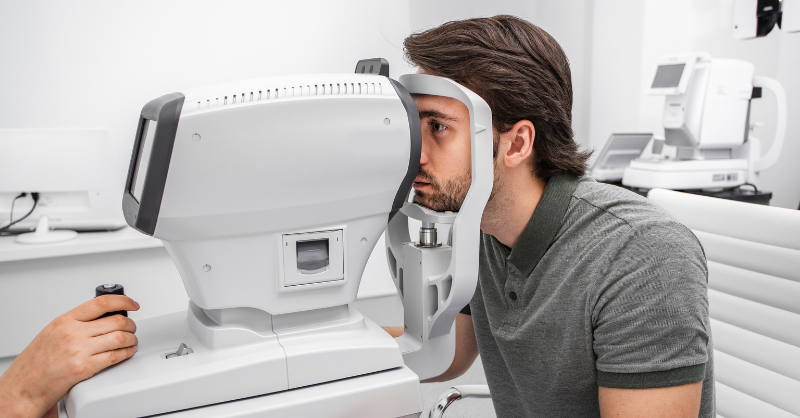7 Things Your Eye Health Can Tell You
Your eyes do more than help you see the world. More than just your windows to the soul, they reveal important clues about your health. Changes in eye appearance, sudden vision problems, or unusual symptoms may signal conditions affecting your wider well-being.
Here are seven eye health issues our specialists have put together that an eye exam might detect, and advice on what to do if we identify any of them.
1. Diabetic Retinopathy

High blood sugar levels can damage tiny blood vessels in the retina—the light-sensitive tissue at the back of your eye-causing swelling, bleeding, or abnormal vessel growth, which are signs of diabetic retinopathy. Untreated diabetic eye conditions can also lead to cataracts, glaucoma, and eventual vision loss.
Early detection, blood sugar control, and attending annual diabetic eye exams can help prevent potential issues that arise from this eye condition. We spend around 40 minutes carrying out a diabetic eye exam, with several detailed assessments, including a 3D OCT scan, which shows us the different layers of your retina in precise detail, so we can see even the smallest changes in your structure that might be caused by diabetes.
If you have diabetes or are at risk, inform your eye doctor and stay on top of your check-ups to maintain healthy vision and peace of mind.
2. Heart disease

Your eyes contain delicate blood vessels that can reflect the condition of your heart and circulation. Signs such as narrowed or twisted vessels or small hemorrhages might suggest cardiovascular problems. Detecting these changes early can prompt further testing with your doctor or at the hospital to reduce the risks of heart attacks or strokes.
3. High blood pressure

Also known as hypertension, this general health problem can affect your eye health by causing damage to the retina’s blood vessels, making them appear narrowed or leaky. The pressure may also cause swelling in the optic nerve, which sends visual signals to the brain.
Regular eye exams, which include retinal photography, may help us catch these signs before you experience other symptoms, helping manage your blood pressure more effectively, before the issue worsens.
4. High cholesterol

Cholesterol deposits can form a white or yellow ring around the cornea (the eye’s clear front surface). This can sometimes indicate elevated cholesterol levels, especially in younger individuals. If we notice this during your eye exam, we will advise you to ask your doctor about checking your lipid levels.
5. Lupus

This autoimmune disease can cause inflammation in various parts of the eye, including the retina and the lining around the eye. Symptoms might include redness, pain, dry eyes, or vision changes. Early detection through an eye exam can prompt better disease management and prevent further complications.
6. Multiple Sclerosis (MS)

MS affects the nervous system, and one of the first signs can be inflammation of the optic nerve – optic neuritis. This may cause sudden sight loss or pain when moving your eyes. If we identify this during an eye exam, we will refer you to a neurologist for further testing, which is crucial to protecting your vision from further damage and managing this serious condition.
7. Vitamin A deficiency

Vitamin A is essential for maintaining a healthy cornea and good night vision. Deficiency can cause dryness, cloudiness, or even blindness if left untreated. Our optometrists may recommend nutritional evaluation or supplements to ensure you get the right nutrients to rectify this deficiency and help promote healthy vision.
You can also try to incorporate more foods that contain vitamin A in your diet, like sweet potatoes, carrots, leafy greens like kale or spinach, salmon, tuna, eggs, and certain fruits like cantaloupe melon, and mangos.
The importance of regular eye exams

Our experienced team of optometrists at our eye doctor clinics in Plano and Dallas TX combines their years of experience and highly advanced technology to capture information about your eyes, revealing changes that traditional eye exams might miss that remain asymptomatic to you on a day-to-day basis.
Eye exams every one or two years, depending on what we advise, are vital for tracking and maintaining eye health and overall well-being. They help us to catch these eye conditions early when they’re most treatable.
Put your health first
Don’t assume you’re clear of signs of unhealthy eyes. Schedule an eye exam with us at our Dallas or Plano practices to discover what your eyes might be telling you and keep your whole body in check. We accept various vision insurance and medical insurance plans and also provide financing to help cover the cost of your eyecare.
